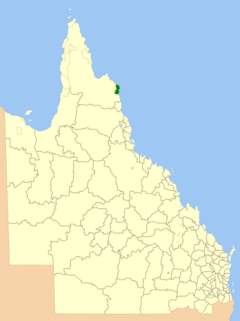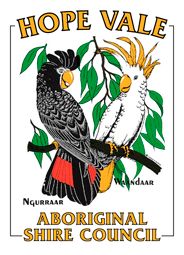Aboriginal Shire of Hope Vale facts for kids
Quick facts for kids Hope Vale Aboriginal ShireQueensland |
|||||||||||||||
|---|---|---|---|---|---|---|---|---|---|---|---|---|---|---|---|

Location within Queensland
|
|||||||||||||||
| Population | 976 (2021 census) | ||||||||||||||
| • Density | 0.8660/km2 (2.243/sq mi) | ||||||||||||||
| Established | 1986 | ||||||||||||||
| Area | 1,127 km2 (435.1 sq mi) | ||||||||||||||
| Mayor | Jason Grant Woibo | ||||||||||||||
| Council seat | Hope Vale | ||||||||||||||
| Region | Far North Queensland | ||||||||||||||
| State electorate(s) | Cook | ||||||||||||||
| Federal Division(s) | Leichhardt | ||||||||||||||
 |
|||||||||||||||
| Website | Hope Vale Aboriginal Shire | ||||||||||||||
|
|||||||||||||||
The Aboriginal Shire of Hope Vale is a special kind of local government area in Far North Queensland, Australia. It is located north of the town of Cooktown. A local government area is like a small region with its own council that helps manage local services.
Most of the land in the Shire is called "Deed of Grant land." This means the land is held for the benefit of the Aboriginal people who have a strong connection to it, including their ancestors and future generations.
In 2021, the Hope Vale Aboriginal Shire had a population of 976 people. Out of these, 863 people (about 88.4%) are Indigenous Australians, who are the original people of Australia.
Contents
History of Hope Vale
The Guugu Yimithirr Language
The Guugu Yimithirr language is an important Australian Aboriginal language. It is spoken by people in Hope Vale and the nearby Cooktown area. This language is also known by other names like Koko Yindjir. The area where it is spoken includes the Hope Vale Aboriginal Shire and parts of the Shire of Cook.
Early Mission and Community Life
The Hope Vale area was first set up as a German Lutheran mission in 1885. A mission is a place where religious groups try to help and teach local people. This mission was about 25 kilometers (15 miles) from where Hope Vale is today. It was known as the Cape Bedford Mission.
During World War II in 1942, the people living at the mission had to move. They were taken to a place called Woorabinda. The land they left behind was then used by the army. Many people faced great difficulties during this time. The survivors were not allowed to return home until 1949. In 1952, the land was officially made an Aboriginal reserve. This meant it was set aside for Aboriginal people.
Becoming a Shire
In 1986, the Hope Vale community received a special land title called a Deed of Grant in Trust. This was part of a law called the Community Services (Aborigines) Act 1984. This deed gave the Hope Vale community more control over their land. Like other communities with this type of deed, Hope Vale got its own Community Council. This council was elected by the Aboriginal people living there.
Who Lives in Hope Vale?
The population of Hope Vale Aboriginal Shire has grown over the years.
- In 2016, there were 918 people living in the Shire. About 92% of them were Indigenous Australians.
- By 2021, the population had increased to 976 people. About 88.4% of these residents were Indigenous Australians.
What the Council Does
The Hope Vale Aboriginal Shire Council works under the laws of Queensland for local governments. However, because the council is also the Trustee of the land, it has extra duties. This means the council has more responsibilities than a typical local government.
For example, the council is responsible for things like:
- Managing fisheries (fishing activities).
- Helping with alcohol management in the community.
- Creating job opportunities for local people.
The Hope Vale Aboriginal Shire Council also runs an Indigenous Knowledge Centre. It is called Nganthaanun-Milbi\Guugu Magubadaaygu. This center is located at the Jack Bambie Memorial Centre in Hope Vale. It helps preserve and share local knowledge and culture.
Leaders of Hope Vale
The leader of the Hope Vale Aboriginal Shire Council is called the Mayor.
- From 2008 to 2020, Gregory Raymond McLean was the Mayor.
- Since 2020, Jason Grant Woibo has been the Mayor.

